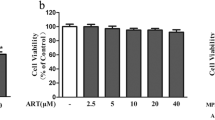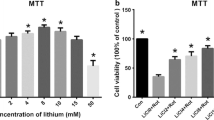Abstract
Background
This study was designed to investigate the neuroprotective effects of bromelain, which is known to have anti-oxidant and anti-inflammatory properties, against the neurotoxicity (induced by 6-OHDA) in SH-SY5Y cells.
Methods and results
To establish Parkinson’s Disease (PD) model in cell culture conditions, SH-SY5Y cells were exposed to 200 µM 6-OHDA for 1 day. Prior to 6-OHDA treatment, SH-SY5Y cells had been pre-treated with bromelain (25 µg/mL, 50 µg/mL, 75 µg/mL and 100 µg/mL). After 1 day, cell viability was determined with the 3-(4,5-Dimethylthiazol-2-yl)-2,5-Diphenyltetrazolium Bromide (MTT) and lactate dehydrogenase (LDH) assays. Oxidative stress was assessed with total antioxidant capacity (TAC), total oxidant status (TOS), glutathione reductase (GR) and malondialdehyde (MDA) analyses. The effect of the bromelain in SH-SY5Ycells was also examined by 4′,6-diamidino-2-phenylindole (DAPI) staining. We found that 6-OHDA increased LDH leakage, and cellular apoptosis in SH-SY5Y cells. 6-OHDA aggravated oxidative stress by increasing TOS, MDA and GR and eventually promoted apoptosis in SH-SY5Y cells, while pretreatment with bromelain attenuated these toxic effects of 6-OHDA.
Conclusions
These findings indicated that bromelain, with its neuroprotective features can be useful for neuroprotection in PD.



Similar content being viewed by others
Data availability
Data and materials are available from the authors upon request.
References
Dorsey ER, Constantinescu R, Thompson J, Biglan K, Holloway R, Kieburtz K, Marshall F, Ravina B, Schifitto G, Siderowf A (2007) Projected number of people with Parkinson disease in the most populous nations, 2005 through 2030. Neurology 68:384–386
Kouli A, Torsney KM, Kuan W-L (2018) Parkinson’s disease: etiology, neuropathology, and pathogenesis. Exon Publications, Brisbane, pp 3–26
Dias V, Junn E, Mouradian MM (2013) The role of oxidative stress in Parkinson’s disease. J Parkinsons Dis 3:461–491
Gupta A, Dawson VL, Dawson TM (2008) What causes cell death in Parkinson’s disease? Ann Neurol 64:S3–S15
Park H-A, Ellis AC (2020) Dietary antioxidants and Parkinson’s disease. Antioxidants 9:570
Saptarini NM, Rahayu D, Herawati IE (2019) Antioxidant activity of crude bromelain of pineapple (Ananas comosus (L.) Merr) crown from Subang district. Indones J Pharm Bioallied Sci 11:S551
Adu TS, Mabandla MV (2019) Effects of bromelain on motor responses following intra-medial forebrain bundle 6-OHDA injection in rat model of parkinsonism. Metabolic Brain Dis 34:1557–1564
Hernandez-Baltazar D, Zavala-Flores L, Villanueva-Olivo A (2017) The 6-hydroxydopamine model and parkinsonian pathophysiology: novel findings in an older model. Neurología (English Edition) 32:533–539
Erel O (2004) A novel automated method to measure total antioxidant response against potent free radical reactions. Clin Biochem 37:112–119
Erel O (2005) A new automated colorimetric method for measuring total oxidant status. Clinical biochemistry 38:1103–1111
Okkay U, Ferah Okkay I, Aydin IC, Bayram C, Ertugrul MS, Gezer A, Hacimuftuoglu A (2021) Effects of Achillea millefolium on cisplatin induced ocular toxicity: an experimental study. Cutan Ocul Toxicol 40:214–220
Park HJ, Shin DH, Chung WJ, Leem K, Yoon SH, Hong MS, Chung JH, Bae JH, Hwang JS (2006) Epigallocatechin gallate reduces hypoxia-induced apoptosis in human hepatoma cells. Life Sci 78:2826–2832
Iglesias-González J, Sánchez-Iglesias S, Méndez-Álvarez E, Rose S, Hikima A, Jenner P, Soto-Otero R (2012) Differential toxicity of 6-hydroxydopamine in SH-SY5Y human neuroblastoma cells and rat brain mitochondria: protective role of catalase and superoxide dismutase. Neurochem Res 37:2150–2160
Abbas S, Shanbhag T, Kothare A (2021) Applications of bromelain from pineapple waste towards acne. Saudi J Biol Sci 28:1001–1009
El-Demerdash FM, Baghdadi HH, Ghanem NF, Al Mhanna AB (2020) Nephroprotective role of bromelain against oxidative injury induced by aluminium in rats. Environ Toxicol Pharmacol 80:103509
Puspita L, Chung SY, Shim J-w (2017) Oxidative stress and cellular pathologies in Parkinson’s disease. Mol Brain 10:1–12
Redza-Dutordoir M, Averill-Bates DA (2016) Activation of apoptosis signalling pathways by reactive oxygen species. Biochim Biophys Acta 1863:2977–2992
Massari CM, Castro AA, Dal-Cim T, Lanznaster D, Tasca CI (2016) In vitro 6-hydroxydopamine-induced toxicity in striatal, cerebrocortical and hippocampal slices is attenuated by atorvastatin and MK-801. Toxicol In Vitro 37:162–168
Okkay U, Ferah Okkay I, Cicek B, Aydin IC, Ertugrul MS, Bayram C, Senyayla S, Sezen S, Mendil AS, Guven L, Hacimuftuoglu A (2021) Achillea millefolium alleviates testicular damage in paclitaxel-intoxicated rats via attenuation of testicular oxido-inflammatory stress and apoptotic responses. Andrologia 53:e14028
Angelova PR, Abramov AY (2018) Role of mitochondrial ROS in the brain: from physiology to neurodegeneration. FEBS Lett 592:692–702
Shi XR, Hong ZY, Liu HR, Zhang YC, Zhu YZ (2011) Neuroprotective effects of SCM198 on 6-hydroxydopamine-induced behavioral deficit in rats and cytotoxicity in neuronal SH-SY5Y cells. Neurochem Int 58:851–860
Kim SM, Park YJ, Shin M-S, Kim H-R, Kim MJ, Lee SH, Yun SP, Kwon S-H (2017) Acacetin inhibits neuronal cell death induced by 6-hydroxydopamine in cellular Parkinson’s disease model. Bioorg Med Chem Lett 27:5207–5212
Mehan S, Kaur G, Dudi R, Rajput M, Kalra S (2017) Restoration of mitochondrial dysfunction in 6-hydroxydopamine induced Parkinson’s disease: a complete review. Open J Park Dis Treat 1:1–26
Tan JW, Kim MK (2016) Neuroprotective effects of bochanin A against β-amyloid-induced neurotoxicity in PC12 cells via a mitochondrial-dependent apoptosis pathway. Molecules 21:548
Silva J, Alves C, Pinteus S, Mendes S, Pedrosa R (2018) Neuroprotective effects of seaweeds against 6-hydroxidopamine-induced cell death on an in vitro human neuroblastoma model. BMC Complement Altern Med 18:1–10
Chen J-H, Ou H-P, Lin C-Y, Lin F-J, Wu C-R, Chang S-W, Tsai C-W (2012) Carnosic acid prevents 6-hydroxydopamine-induced cell death in SH-SY5Y cells via mediation of glutathione synthesis. Chem Res Toxicol 25:1893–1901
Ossola B, Kaarainen TM, Raasmaja A, Mannisto PT (2008) Time-dependent protective and harmful effects of quercetin on 6-OHDA-induced toxicity in neuronal SH-SY5Y cells. Toxicology 250:1–8
Watjen W, Michels G, Steffan B, Niering P, Chovolou Y, Kampkotter A, Tran-Thi Q-H, Proksch P, Kahl R (2005) Low concentrations of flavonoids are protective in rat H4IIE cells whereas high concentrations cause DNA damage and apoptosis. J Nutr 135:525–531
Mischley LK, Standish LJ, Weiss NS, Padowski JM, Kavanagh TJ, White CC, Rosenfeld ME (2016) Glutathione as a biomarker in Parkinson’s disease: associations with aging and disease severity. Oxid Med Cell Longev. https://doi.org/10.1155/2016/9409363
Ahiskali I, Ferah Okkay I, Mammadov R, Okkay U, Keskin Cimen F, Kurt N, Suleyman H (2021) Effect of taxifolin on cisplatin-associated oxidative optic nerve damage in rats. Cutan Ocul Toxicol 40:1–6
Wang H-L, Zhang J, Li Y-P, Dong L, Chen Y-Z (2021) Potential use of glutathione as a treatment for Parkinson’s disease. Exp Ther Med 21:1–1
Ko Y-H, Kim S-K, Kwon S-H, Seo J-Y, Lee B-R, Kim Y-J, Hur K-H, Kim SY, Lee S-Y, Jang C-G (2019) 7, 8, 4′-Trihydroxyisoflavone, a metabolized product of daidzein, attenuates 6-hydroxydopamine-induced neurotoxicity in SH-SY5Y cells. Biomol Ther 27:363
Antunes MS, Goes AT, Boeira SP, Prigol M, Jesse CR (2014) Protective effect of hesperidin in a model of Parkinson’s disease induced by 6-hydroxydopamine in aged mice. Nutrition 30:1415–1422
Costa-Silva DG, Lopes AR, Martins IK, Leandro LP, Nunes MEM, de Carvalho NR, Rodrigues NR, Macedo GE, Saidelles AP, Aguiar C, Doneda M, Flores EMM, Posser T, Franco JL (2018) Mancozeb exposure results in manganese accumulation and Nrf2-related antioxidant responses in the brain of common carp Cyprinus carpio. Environ Sci Pollut Res Int 25:15529–15540
Adiga U, D’souza J, Kousalya R, Rao GM, Nandini M, D’souza V (2006) Total antioxidant activity in Parkinson’s disease. Biomed Res 17:145–147
Verma AK, Raj J, Sharma V, Singh TB, Srivastava S, Srivastava R (2015) Plasma prolidase activity and oxidative stress in patients with Parkinson’s disease. Parkinson’s Dis. https://doi.org/10.1155/2015/598028
Romuk E, Szczurek W, Nowak P, Skowron M, Prude B, Hudziec E, Chwalińska E, Birkner E (2016) Effects of propofol on oxidative stress parameters in selected parts of the brain in a rat model of Parkinson disease. Postepy Hig Med Dosw. https://doi.org/10.5604/17322693.1227841
Chaudhary B, Agarwal S, Bist R (2018) Invulnerability of bromelain against oxidative degeneration and cholinergic deficits imposed by dichlorvos in mice brains. Front Biol 13:56–62
Casares D, Escribá PV, Rosselló CA (2019) Membrane lipid composition: effect on membrane and organelle structure, function and compartmentalization and therapeutic avenues. Int J Mol Sci 20:2167
Porres-Martínez M, González-Burgos E, Carretero ME, Gómez-Serranillos MP (2015) Protective properties of Salvia lavandulifolia Vahl. essential oil against oxidative stress-induced neuronal injury. Food Chem Toxicol 80:154–162
Agarwal S, Chaudhary B, Bist R (2016) Bacoside A and bromelain relieve dichlorvos induced changes in oxidative responses in mice serum. Chemico-Biol Interact 254:173–178
Kaji H, Matsui-Yuasa I, Matsumoto K, Omura A, Kiyomoto K, Kojima-Yuasa A (2020) Sesaminol prevents Parkinson’s disease by activating the Nrf2-ARE signaling pathway. Heliyon 6:e05342
Pichla M, Pulaski Ł, Kania KD, Stefaniuk I, Cieniek B, Pieńkowska N, Bartosz G, Sadowska-Bartosz I (2020) Nitroxide radical-containing redox nanoparticles protect neuroblastoma SH-SY5Y cells against 6-hydroxydopamine toxicity. Oxid Med Cell Longev. https://doi.org/10.1155/2020/9260748
Funding
The authors did not receive any financial support.
Author information
Authors and Affiliations
Contributions
IFO and UO performed the experiments and wrote the manuscript; BC and ASM contributed significantly to the experiments and data analysis; AH contributed to the conception of the study; others assisted with the experiments.
Corresponding author
Ethics declarations
Conflict of interest
The authors declared no conflict of interest.
Consent to participate
All individuals have signed consent forms before sample acquisition. Information on potential publications is included in consent forms signed by all individuals.
Consent for publication
The participants were informed about publishing the results and they all agreed.
Additional information
Publisher’s Note
Springer Nature remains neutral with regard to jurisdictional claims in published maps and institutional affiliations.
Rights and permissions
About this article
Cite this article
Ferah Okkay, I., Okkay, U., Cicek, B. et al. Neuroprotective effect of bromelain in 6-hydroxydopamine induced in vitro model of Parkinson’s disease. Mol Biol Rep 48, 7711–7717 (2021). https://doi.org/10.1007/s11033-021-06779-y
Received:
Accepted:
Published:
Issue Date:
DOI: https://doi.org/10.1007/s11033-021-06779-y




